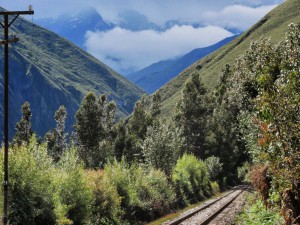
The Urubamba River Valley Regional Wastewater Initiative represents an evolving role for WEFTA. WEFTA provides expert technical advice, especially related to water and wastewater treatment, in countries and regions where such expertise is hard to find or non-existent, but funding for implementation and operation comes largely from local, in-country sources.
This is just the role WEFTA is playing in the Urubamba River Valley of Peru, just north of the city of Cuzco in the Peruvian Andes. Funding for construction of important infrastructure has become available, to a large degree, from royalties paid by international mining and natural gas companies to the Peruvian government, and in turn made available to the local provincial governments to develop such needed infrastructure. Where WEFTA comes in is in the evaluation of alternative treatment technologies, procedures, and equipment when it comes to the treatment of wastewater produced at each urban center within the valley. The project area for the time being is limited to the region between towns of Pisac and Ollantaytambo, commonly referred to as the Sacred Valley of the Incas.
In a recent trip to Peru our WEFTA team was able to provide just such advice, not only to the municipal public works personnel in towns up and down the Urubamba River Valley, but also to civil engineering consultants hired by the local officials. The civil engineers the WEFTA team spoke with in Peru clearly had a strong understanding of hydraulics and how to design water distribution and wastewater collection systems. However, some of these engineers confirmed that the universities in Peru don’t typically include a strong water and wastewater treatment component in their civil engineering programs, especially in the case of wastewater. And unfortunately there are not many working treatment plants in rural Peru, as the custom has typically been to dump sewage waste directly into the rivers and streams and let Mother Nature do the ‘treatment.’ With the tremendous growth in recent decades of these urban centers in otherwise rural Peru, such as those along the Urubamba River, together with the increase in use of non-biodegradable goods, the river reached and passed the tipping point many years ago. This river that was once used by the locals to bathe in and catch large fish from is now a source of disgust and shame for the locals. The need for wastewater treatment plants at each urban center is long overdue.
However, the local engineering consultants are the first to admit that treatment technologies, especially pertaining to secondary and tertiary treatment, are something they are largely unfamiliar with. WEFTA is fortunate to count on several civil engineers who actually specialize in such treatment systems design, be it for potable water or wastewater. Some have decades of experience and have developed a very high level of expertise, and are more than willing to share it with such communities of Latin America who would not otherwise have access to such a knowledge base.
The team that travelled to Peru in March of 2013 was fortunate to arrive at a critical moment in the wastewater system design processes, especially in the case of the Municipality of Calca, the capital of the province of the same name. The local government recently hired a consultant to design a wastewater collection and treatment system for this community of 12,000 people. Upon reviewing the proposed wastewater treatment plant, it became apparent that the local consultant had a solid understanding of hydraulics and at least primary treatment; however the proposed secondary treatment portion of the plant raised more questions than provided convincing solutions. The local consultant actually had no experience with the technology that he himself was proposing, but understood it had been used in northern Peru. The WEFTA team was familiar with it and also of its limitations. This system was clearly not the best option and WEFTA followed up the site visit with a design memo that, as tactfully as possible, explained the shortfalls of the proposed system and went on to illustrate alternative technologies which would be more effective and efficient to implement, and then to operate and maintain over the long term.
In the case of the Municipality of Urubamba, a large town downstream from Calca, WEFTA developed and signed an MOU whereby our commitment to the shared dream of cleaning the Urubamba River was formalized, as well as the local government’s commitment to make available to WEFTA the key data necessary for us to provide useful and informed advice and counsel. The team provided a similar follow-up memo to the officials of Urubamba and coordinated with other communities up and down the valley with similar advice, all of which is provided on a volunteer basis by the WEFTA team. The only cost to WEFTA has to do with the travel costs of our volunteers, at least those not already covered by our volunteers. The expert advice and counsel provided by WEFTA’s pool of engineers and hydrogeologists is on a completely volunteer basis.
We are confident that this role for WEFTA is an important one and one that will only expand elsewhere in Latin America as more and more communities become aware of what our volunteers have to offer, and with no other goal than to ensure the welfare of the local population and help protect the environment from the detrimental effects of rapid population growth, especially pertaining to the treatment and disposal of wastewater.
Please see the trip reports available at each country page under the “Where We Work” tab. Also available on the Peru page is the design memo prepared by John Lincoln with input from Peter Fant and Scott Rogers, three of our most senior engineers, with long careers in water and wastewater system design throughout the U.S.
Click here to go to a technical photo tour of the trip
Click here to go to our photo album of the beautiful Urubamba Valley



